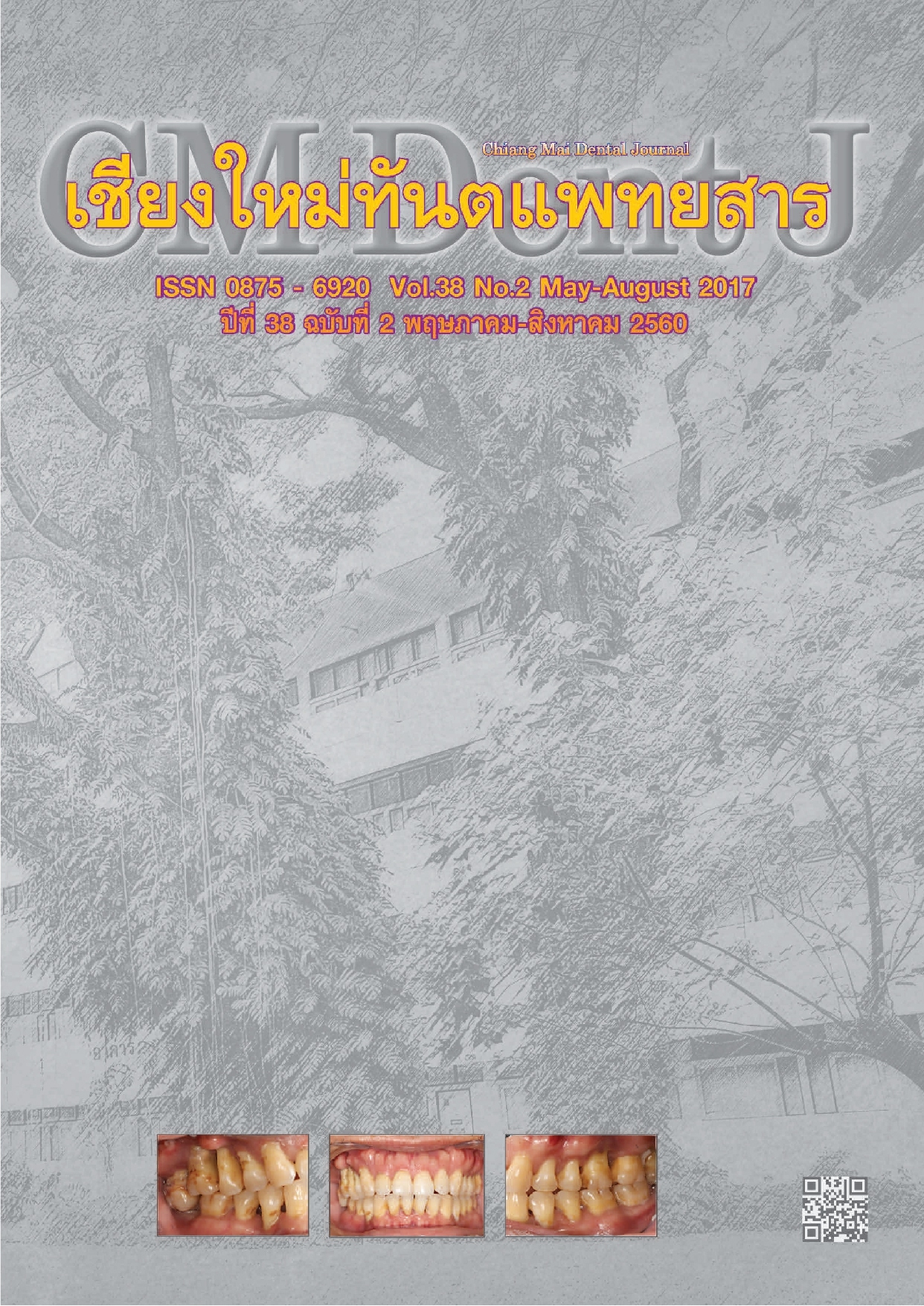Effect of Proanthocyanidin on the Microtensile Bond Strength of Pulp Chamber Dentin after NaOCI Irrigation to Resin Composite using Self-etching Bonding System
Main Article Content
Abstract
To evaluate the effect of proanthocyanidin in grape seed extract on the microtensile bond strength between a self-etch adhesive and NaOCl treated pulp chamber dentin. Twenty extracted human molar teeth, were opened access, irrigated with 17%EDTA, 5.25% NaOCl and distilled water. Specimens were divided into four groups, Group 1 no treatment; Groups 2-4 , treated followed by 30% proanthocyanidin, 10% sodium ascorbate or 2% chlorhexidine respectively. All specimens were filled the access with resin composite using self-etched adhesive. Specimens were sectioned and trimmed prepared for microtensile bond strength test. Twenty specimens in each group were subjected to a microtensile bond strength test. There was no significant difference in microtensile bond strength between group 2-4 and microtensile bond strengths in group 2-4 were significantly higher than the group 1 (p<0.05). The 30% proanthocyanidin from grape seed extract, 10% sodium ascorbate and 2% chlorhexidine improved microtensile bond strengths between a self-etch adhesive and dentin after NaOCl irrigation.
Article Details
References
Gillen BM, Looney SW, Gu LS, et al. Impact of the quality of coronal restoration versus the quality of root canal fillings on success of root canal treatment: a systematic review and meta-analysis. J Endod 2011; 37: 895-902.
Schwartz RS, Fransman R. Adhesive dentistry and endodontics: materials, clinical strategies and procedures for restoration of access cavities: a review. J Endod 2005; 31: 151-165.
Lai SC, Mak YF, Cheung GS, et al. Reversal of compromised bonding to oxidized etched dentin. J Dent Res 2001; 80: 1919-1924.
Santos JN, Carrilho MR, De Goes MF, et al. Effect of chemical irrigants on the bond strength of a self-etching adhesive to pulp chamber dentin. J Endod 2006; 32: 1088-1090.
Yiu CK, Garcia-Godoy F, Tay FR, et al. A nanoleakage perspective on bonding to oxidized dentin. J Dent Res 2002; 81: 628-632.
Weston CH, Ito S, Wadgaonkar B, et al. Effects of time and concentration of sodium ascorbate on reversal of NaOCl-induced reduction in bond strengths. J Endod 2007; 33: 879-881.
Celik C, Erkut S, Gulsahi K, et al. Effect of sodium ascorbate on bond strength of different adhesive systems to NaOCl-treated dentin. Aust Endod J 2010; 36: 12-18.
Vongphan N, Senawongse P, Somsiri W, et al. Effects of sodium ascorbate on microtensile bond strength of total-etching adhesive system to NaOCl treated dentine. J Dent 2005; 33: 689-695.
Jardim PS, Pereira-Cenci T, Badin CF, et al. The effect of endodontic chemicals on the retention of fiber posts luted using a self-adhesive cement. Applied Adhesion Science 2014; 2: 20.
Erdemir A, Ari H, Gungunes H, et al. Effect of medications for root canal treatment on bonding to root canal dentin. J Endod 2004; 30: 113-116.
Nagpal R, Manuja N, Pandit IK. Effect of proanthocyanidin treatment on the bonding effectiveness of adhesive restorations in pulp chamber. J Clin Pediatr Dent 2013; 38: 49-53.
Bagchi D, Garg A, Krohn RL, et al. Oxygen free radical scavenging abilities of vitamins C and E, and a grape seed proanthocyanidin extract in vitro. Res Commun Mol Pathol Pharmacol 1997; 95: 179-189.
Fine AM. Oligomeric proanthocyanidin complexes: history, structure, and phytopharmaceutical applications. Altern Med Rev 2000; 5: 144-151.
Vidhya S, Srinivasulu S, Sujatha M, et al. Effect of grape seed extract on the bond strength of bleached enamel. Oper Dent 2011; 36: 433-438.
Abraham S, Ghonmode WN, Saujanya KP, et al. Effect of grape seed extracts on bond strength of bleached enamel using fifth and seventh generation bonding agents. J Int Oral Health 2013; 5: 101-107.
Ishizuka T, Kataoka H, Yoshioka T, et al. Effect of NaOCl treatment on bonding to root canal dentin using a new evaluation method. Dent Mater J 2001; 20: 24 - 33.
Purk JH, Dusevich V, Glaros A, et al. In vivo versus in vitro microtensile bond strength of axial versus gingival cavity preparation walls in Class II resin-based composite restorations. J Am Dent Assoc 2004; 135: 185-193; quiz 228.
Clarkson RM, Moule AJ. Sodium hypochlorite and its use as an endodontic irrigant. Aust Dent J 1998; 43: 250-256.
Kunawarote S, Nakajima M, Shida K, et al. Effect of dentin pretreatment with mild acidic HOCl solution on microtensile bond strength and surface pH. J Dent 2010; 38: 261-268.
Yoshida Y, Nagakane K, Fukuda R, et al. Comparative study on adhesive performance of functional monomers. J Dent Res 2004; 83: 454-458.
Mountouris G, Silikas N, Eliades G. Effect of sodium hypochlorite treatment on the molecular composition and morphology of human coronal dentin. J Adhes Dent 2004; 6: 175-182.


